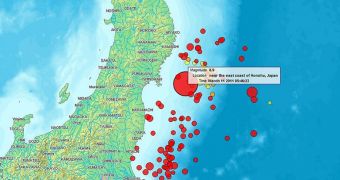Seismologists, geologists and astronomers are beginning to come to terms with the scale of the megathrust earthquake that struck Japan at 05:46 UTC (14:46 Tokyo time) on March 11, 2011. The tremor was found to have shifted Earth's axis, as well as the country's shorelines.
Dr. Dave Applegate, an expert with the United States Geological Survey (USGS), says that the planetary axis was permanently shifted by about 10 inches (25.4 centimeters) as a result.
Additionally, early measurements have also demonstrated that the Japanese shorelines were permanently shifted by as much as 2.4 meters (7.8 feet) as well, the Vancouver Sun reports.
Similar effects were recorded after the 8.8-magnitude earthquake that slammed the coasts of Chile at the beginning of 2010. That event shifted cities all over South America by several inches.
The tremor struck Chile on February 27, and was later established to be the fifth-strongest in recorded history. It was also one of the most interesting to study, from a geological perspective.
It would appear that scientists have a great deal to learn from it, and also from the changes that it caused to the planet. It apparently nudged our planet's figure axis off-course by a few inches, and experts revealed that it also shifted entire cities several meters in specific directions.
The Chilean city of Concepcion had it worst off. Precise comparison of GPS measurements taken before and after the tremor appears to indicate that the entire urban center has been moved about 10 feet (roughly 3 meters) to the west.
In Japan, the effects were even more severe because the geological event that led to the tremor were produced when fault lines around the country ruptured a180 mile by 50 mile (190 by 80 kilometer) section of the planetary crust.
In less than 24 hours after the original, 8.9-magnitude earthquake struck, automatic measurement networks captured more than 100 aftershocks of magnitude 5 or higher, and countless other of lower magnitudes, the USGS expert adds.
He goes on to say that the 2011 Honshu earthquake bumped directly into more than 250 miles of Japanese coastlines, which is why it caused such widespread damage. The ensuing tsunamis reached a maximum height of about 32 feet (nearly 10 meters).
At this point, preliminary reports show that the earthquake, aftershocks and ensuing tsunamis killed more than 503 people in Japan (and a yet-unconfirmed person in California). About 784 people are currently declared missing.
These tolls may soon change, however, so keep an eye on this space for updates.

 14 DAY TRIAL //
14 DAY TRIAL //